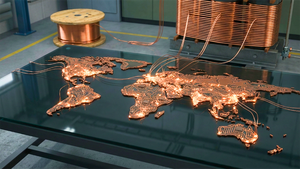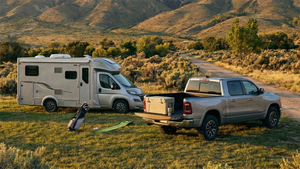AEye and Continental Selected by AutoSens Panel of Automotive Industry Luminaries for Lidar Leadership in Developing Groundbreaking ADAS and Autonomous Vehicle Product
AEye, Inc. (NASDAQ: LIDR), a global leader in adaptive, high-performance lidar solutions, today announced that AutoSens has named Continental’s HRL131 long-range lidar sensor, built on AEye’s 4Sight Intelligent Sensing Platform, the Lidar Development of the Year. AutoSens is the world’s leading conference for Advanced Driver Assistance Systems (ADAS), automotive safety systems, and autonomous vehicle technology development. The prestigious AutoSens award recognizes the best lidar sensor, processor, or other innovation that will further autonomous vehicle development. Continental and AEye were also recognized by AutoSens as 20/20 visionaries for their joint development of the HRL131 product.
The HRL131 is on track to be the first high-resolution, solid-state, long-range lidar sensor in the world to enter series production in the automotive market, joining Continental’s automotive grade short-range lidar, the HFL110, which is now in series production.
AEye’s reference architecture and licensing model allows Continental to leverage AEye’s 4Sight lidar platform to design and manufacture the HRL131 for automotive series production. The long-range, high-performance HRL131 is an essential component in Continental’s full stack automotive-grade system for Level 2 to Level 4 automated and autonomous driving applications. The HRL131 complements radar, camera and ultrasonic technologies in Continental’s sensor suite, and enables a reliable and redundant Automated Driving platform that can handle complex, diverse traffic scenarios and adverse weather conditions.
Lidar Development of the Year
AEye and Continental jointly developed the HRL131, a unique high-performance, long-range lidar sensor produced by Continental, and based on AEye’s patented adaptive reference architecture. The HRL131 is a software-definable hardware unit for passenger and commercial vehicles that can dynamically adjusts its scan pattern to the optimal setting for any automated driving application – including highway driving or dense urban environments, and in adverse weather conditions, such as direct sun, night, rain, snow, fog, dust, or smoke. Featuring a range exceeding 500 meters, the HRL131 has the ability to detect vehicles at more than 300 meters and pedestrians at more than 200 meters; the HRL131 is a commercialized product slated for mass production in 2024.
“Together with AEye, we’ve created a groundbreaking product that supports Continental’s goal of Vision Zero: a goal for a future with zero fatalities, zero injuries, and zero crashes,” said Gunnar Juergens, Head of Product Line LiDAR at Continental. “By combining high dynamic spatial resolution with long-range detection and software-definability, the HRL131 long-range lidar sensor can handle the most difficult, dynamic environments for autonomous driving – from high-speed highway scenarios to densely packed urban roads – making it a critical component to enable the future of autonomous mobility.”
“Unlike mechanical lidar scanners, the HRL131 allows vehicle manufacturers to easily optimize the hardware field of view and resolution depending on the use cases,” said Jordan Greene, General Manager of Automotive at AEye. “These customized performance modes enable one sensor to operate in multiple environments under various driving conditions while maintaining optimal size, weight, power, and cost profile. This is revolutionary in the automotive industry and will play a significant role in the advancement of safer, reliable vehicle autonomy.”
20/20 Visionary
This is the second consecutive year that AEye has received a 20/20 Vision Award, bestowed upon engineering leadership that inspires progress throughout the vehicle perception ecosystem. This year’s award recognizes the engineers at AEye and Continental responsible for building the HRL131. The team consists of over 300 Continental and AEye lidar engineers across North America, Mexico, and Europe. The two groups function as a sharp, singular team, with AEye serving as a technology innovation partner in the area of lidar, and Continental serving as the technology system integrator having the system and industrialization expertise needed to produce quality, automotive-grade products, at scale. The two companies have co-located engineers in their Santa Barbara and Dublin, CA, offices, and have integrated testing and validation processes and methodologies.
About AEye
AEye’s unique software-defined lidar solution enables advanced driver-assistance, vehicle autonomy, smart infrastructure, logistics and off-highway applications that save lives and propel the future of transportation and mobility. AEye’s 4Sight™ Intelligent Sensing Platform, with its adaptive sensor-based operating system, focuses on what matters most: delivering faster, more accurate, and reliable information. AEye’s 4Sight™ products, built on this platform, are ideal for dynamic applications which require precise measurement imaging to ensure safety and performance. AEye has a global presence through its offices in Germany, Japan, Korea, and the United States.
About Continental
Continental develops pioneering technologies and services for sustainable and connected mobility of people and their goods. Founded in 1871, the technology company offers safe, efficient, intelligent, and affordable solutions for vehicles, machines, traffic, and transportation. In 2021, Continental generated sales of €33.8 billion and currently employs more than 190,000 people in 58 countries and markets. On October 8, 2021, the company celebrated its 150th anniversary.
Forward-Looking Statements
Certain statements included in this press release that are not historical facts are forward-looking statements within the meaning of the federal securities laws, including the safe harbor provisions under the United States Private Securities Litigation Reform Act of 1995. Forward-looking statements are sometimes accompanied by words such as “believe,” “continue,” “project,” “expect,” “anticipate,” “estimate,” “intend,” “strategy,” “future,” “opportunity,” “predict,” “plan,” “may,” “should,” “will,” “would,” “potential,” “seem,” “seek,” “outlook,” and similar expressions that predict or indicate future events or trends, or that are not statements of historical matters. Forward-looking statements are predictions, projections, and other statements about future events that are based on current expectations and assumptions and, as a result, are subject to risks and uncertainties. Forward looking statements included in this press release include statements about the use of AEye’s products as part of an automotive autonomy or Advanced Driver Assistance Systems solution, the benefits and features of such products, and the timing of the mass production of these products, as well as the use of lidar generally, among others. These statements are based on various assumptions, whether or not identified in this press release. These forward-looking statements are provided for illustrative purposes only and are not intended to serve as and must not be relied on by an investor as a guarantee, an assurance, a prediction, or a definitive statement of fact or probability. Actual events and circumstances are very difficult or impossible to predict and will differ from the assumptions. Many actual events and circumstances are beyond the control of AEye. Many factors could cause actual future events to differ from the forward-looking statements in this press release, including but not limited to: (i) the risks that HRL131 may not be the first high-resolution, solid-state, long-range lidar sensor in the world, nor achieve series production in the automotive market in the timeframe anticipated, or at all; (ii) the risks that HRL131 may not enable a reliable and redundant automated driving platform that can handle complex and diverse traffic scenarios as well as adverse weather conditions as anticipated, or at all; (iii) the risks that the HRL131 may not be essential for Level 2 to Level 4 automated and autonomous driving applications either due to the HRL131’s inability to do so, superior competitive products, or otherwise; (iv) the risks that HRL131 may not be capable of dynamically optimizing its scan pattern for any automated driving application or adverse weather condition as anticipated, or at all; (v) the risks that HRL131 may not satisfy range or object detection at distances anticipated, or at all; (vi) the risks that HRL131 may not enter mass production as anticipated in 2024, or at all; (vii) the risks that HRL131 may not handle the most difficult, dynamic environments for autonomous driving as anticipated, or at all; (viii) the risks that HRL131 may not allow vehicle manufacturers to easily optimize hardware field of view and resolution as anticipated, or at all; (ix) the risks that HRL131 may not be capable of operating in multiple environments under various driving conditions as a single sensor as anticipated; (x) the risks that HRL131 may not provide an optimal size, weight, power, or cost profile as may be required by customers; (xi) the risks that capabilities associated with the HRL131 may not be considered revolutionary by customers in the automotive industry; (xii) the risks that lidar adoption occurs slower than anticipated or fails to occur at all; (xiii) the risks that our products will not meet the diverse range of performance and functional requirements of target markets and customers; (xiv) the risks that our products will not function as anticipated by AEye, Continental, or by target markets and customers; (xv) the risks that AEye or Continental may not be in a position to adequately or timely address either the near or long-term opportunities that may or may not exist in the evolving autonomous transportation industry; (xvi) the risks that laws and regulations are adopted impacting the use of lidar that AEye or Continental is unable to comply with, in whole or in part; (xvii) the risks associated with changes in competitive and regulated industries in which AEye and Continental operate, variations in operating performance across competitors, and changes in laws and regulations affecting AEye’s or Continental’s business; (xviii) the risks that AEye or Continental is unable to adequately implement business plans, forecasts, and other expectations, and identify and realize additional opportunities; and (xix) the risks of downturns and a changing regulatory landscape in the highly competitive and evolving industry in which AEye and Continental operate. These risks and uncertainties may be amplified by the COVID-19 pandemic, including the Delta and Omicron variants, as well as future variants and subvariants, which has caused significant economic uncertainty. The foregoing list of factors is not exhaustive. You should carefully consider the foregoing factors and the other risks and uncertainties described in the “Risk Factors” section of the Quarterly Report on Form 10-Q that AEye has most recently filed with the U.S. Securities and Exchange Commission, or the SEC, and other documents filed by us or that will be filed by us from time to time with the SEC. These filings identify and address other important risks and uncertainties that could cause actual events and results to differ materially from those contained in the forward-looking statements. Forward-looking statements speak only as of the date they are made.
Readers are cautioned not to put undue reliance on forward-looking statements; AEye assumes no obligation and does not intend to update or revise these forward-looking statements, whether as a result of new information, future events, or otherwise. AEye gives no assurance that AEye will achieve any of its expectations.
View source version on businesswire.com: https://www.businesswire.com/news/home/20220919005254/en/
Contacts
Media:
Jennifer Deitsch
AEye, Inc.
jennifer@aeye.ai
925-400-4366
Andie Davis
Landis Communications Inc.
AEye@landispr.com
415-717-9133
Investors:
Clyde Montevirgen
AEye, Inc.
cmontevirgen@aeye.ai
925-400-4366
Will Stack
Lambert & Co.
AEye@lambert.com
212-971-9718



